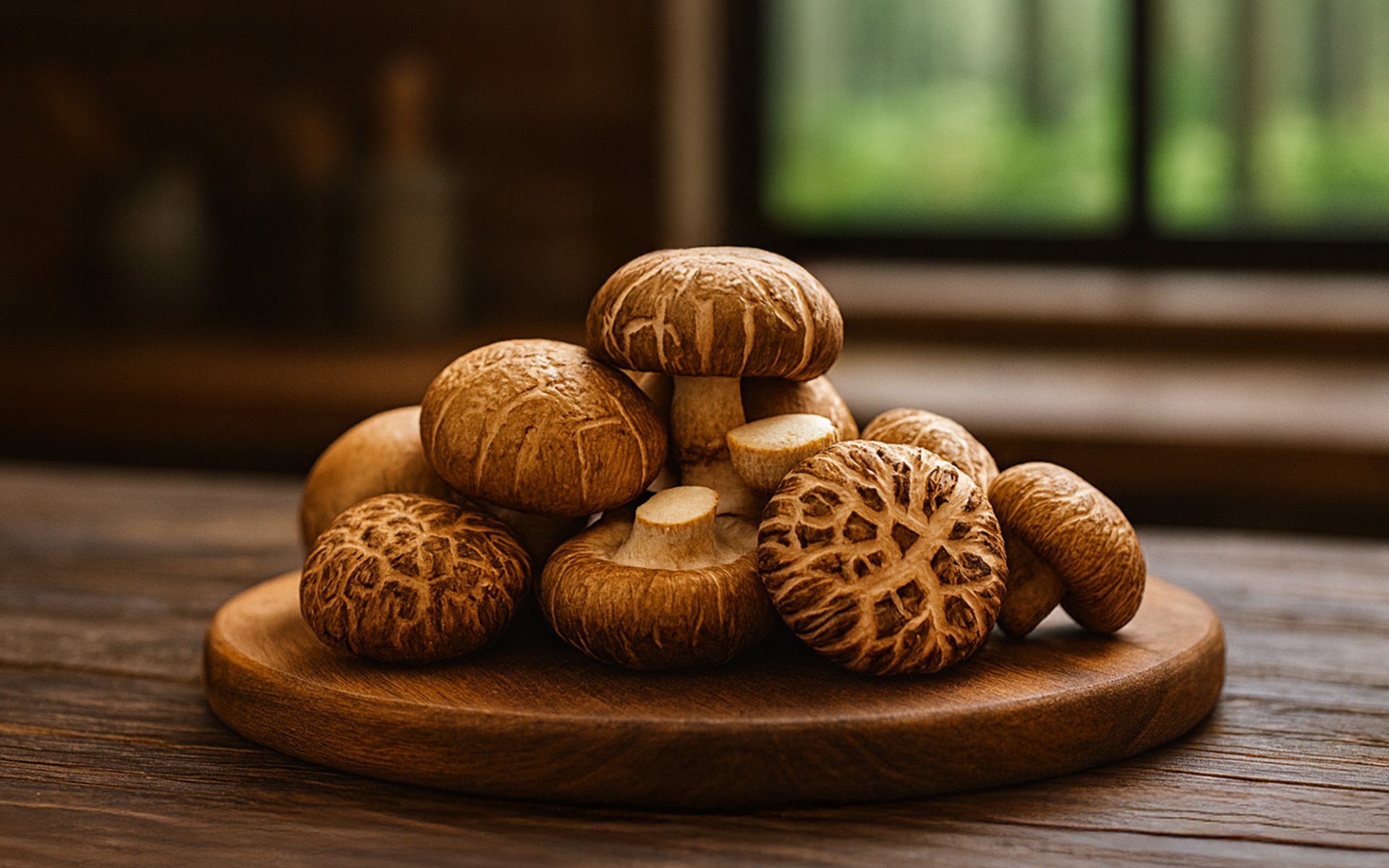Shiitake Mushroom

Among the many edible mushrooms used around the world, the Shiitake mushroom stands out as one of the most culturally and historically significant, especially in East Asia. This mushroom is not only an essential ingredient in countless dishes but also deeply intertwined with traditional medicine and the everyday lives of people for over a millennium.
Origins and Scientific Classification
Shiitake mushrooms, scientifically known as Lentinula edodes, are native to East Asia, especially the forests of China, Japan, and Korea. They naturally grow on hardwood logs, such as oak, which provide a rich food source for their development.
The name Shiitake is derived from Japanese, where Shii refers to a type of tree (Castanopsis or similar hardwood) and Take means mushroom together meaning mushroom that grows on trees, reflecting its natural growth habitat.
Early Use and Medicinal Importance in China
The earliest records of Shiitake mushrooms date back to Song Dynasty China (9601279 AD), where they were recognized for both their culinary and medicinal properties. Ancient Chinese medical texts praised the mushroom for its ability to boost immunity and support overall wellness.
In traditional Chinese sources, Shiitake mushrooms were referred to by names such as Xiānggū (香菇) meaning fragrant mushroom, and Dōnggū (冬菇) meaning winter mushroom, reflecting its strong aroma and long shelf life during cold seasons.
By the Ming Dynasty (13681644), the cultivation of Shiitake mushrooms had begun in Southern China, especially in Fujian, Zhejiang, and Guangdong provinces. Chinese farmers pioneered a technique of drilling holes into logs and inoculating them with mushroom spores, forming the foundation of modern Shiitake cultivation methods.
Introduction to Japan and Buddhist Influence
During the 12th13th centuries, Shiitake mushrooms were introduced to Japan by Chinese monks traveling to spread Buddhism. The mushroom became popular among the nobility and monks due to its rich umami flavor and nutritional value. Its inclusion in the vegetarian diets of Buddhist practitioners further increased its importance as a key source of protein.
In the Edo period (16031867), Shiitake cultivation in Japan became more systematic. Japanese farmers adopted and enhanced Chinese techniques, carefully selecting mushroom strains and refining cultivation methods to suit Japans climate.
Technological Advancements in Cultivation
In the 1960s, Shiitake cultivation saw a major breakthrough when scientists developed substrate-based methods using agricultural byproducts like rice husks, straw, and other organic materials. This innovation allowed for year-round production at lower costs.
Alongside improved preservation and transportation methods, such as drying, freezing, and vacuum packaging, Shiitake mushrooms became easier to export and distribute internationally.
Global Expansion: Shiitake Reaches the West
Shiitake mushrooms made their way to the Western world in the late 19th century through Asian trade routes and migration. Chinese and Japanese immigrants brought dried Shiitake mushrooms with them to use in traditional cooking.
In the United States, awareness of Shiitake mushrooms grew during the 1960s, driven by rising interest in Asian cuisine and health-focused diets. Japanese and Chinese restaurants in major American cities began incorporating Shiitake mushrooms into their dishes.
Commercial cultivation of Shiitake mushrooms in the West began in the 1970s, with Pennsylvania and California among the first states in the U.S. to adapt Japanese cultivation techniques for local production.
Medicinal Uses in Traditional and Modern Science
Throughout history, Shiitake mushrooms have been valued not only as food but also as traditional medicine in both Chinese and Japanese healing systems. Ancient texts cite their ability to restore energy, boost the immune system, and aid in recovery.
Modern scientific research has confirmed many of these benefits. Shiitake mushrooms contain compounds like:
- Beta-glucans known to strengthen immune function
- Eritadenine helps reduce cholesterol levels
- Lentinan a compound with anti-cancer properties
These findings have significantly increased Shiitakes value in the health food and nutraceutical market.
Todays Global Shiitake Industry
Today, China is the largest producer of Shiitake mushrooms, accounting for approximately 90% of global production, followed by Japan, South Korea, and Taiwan. The modern Shiitake industry is built on advanced technology, ensuring optimal conditions for cultivation, harvesting, and processing.
High-tech systems control temperature, humidity, and air circulation, resulting in consistent quality and efficient production. The industry has also expanded into value-added products such as dried mushrooms, pickled varieties, mushroom powder, and ready-to-eat items, increasing the mushrooms global market potential.
You can find premium Shiitake mushrooms at Rimping Supermarket available at all branches.


